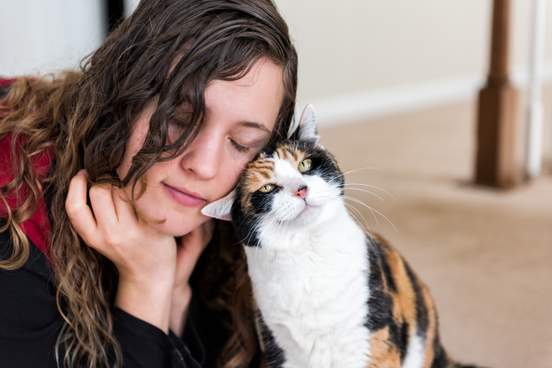
Bunt
We have it on good authority (ahem) that cats are fond of head-butting their people, even going so far to knock books out of their hands while they are reading. What gives? This behavior is known as bunting. Different animals bunt for a variety of reasons, but experts say that cats do it to either mark a person or other animal with their scent. These same experts say that bunting appears to be social, affectionate behavior, and sometimes is done to get attention.
The word bunt goes back to the 1500s, where it was a dialect term used in England that meant “to butt with the head.” It's an alteration of the earlier verb butt, which also means “to strike or thrust.” Butt goes back to the 12th century and was first used not of cats bunting, or rams knocking their heads together, but of a child in the womb that was starting “to stirenn and ... to buttenn.”
You are probably more familiar with bunt as a baseball term to refer to pushing or tapping a baseball lightly without swinging the bat. The baseball bunt is a direct descendant of the head-butting bunt.
Bunting is how felines sharing space together can exchange scents so everyone smells the same. Even if it’s just you and your family and one cat, you are part of the cat’s “colony,” so you may be included in this bonding ritual, essential for the cat’s well-being.
— Sally Cragin, The Sentinel & Enterprise (Fitchburg, Massachusetts), 3 Sep. 2023
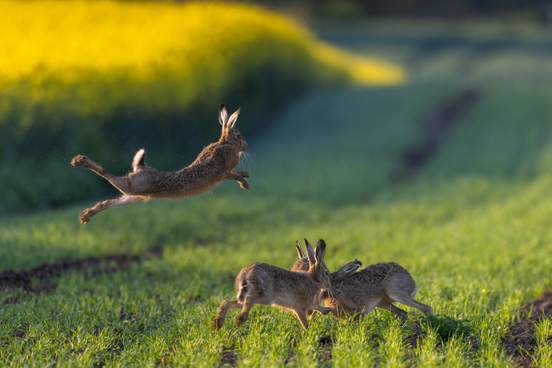
Binky
Definition: of rabbits : to exhibit an excited state or behavior (such as leaping)
Everyone knows that bunnies hop, but few may be aware that they also binky. The word binky has nothing to do with the trademarked brand of pacifiers, however. It is used instead (as both noun and verb) to refer to a particular rabbit behavior, usually a big hop or jump and especially one involving a twist of the body. There’s some debate over whether binkying is an adaptation of predator-avoidance behavior that enables the rabbit to quickly change direction while running away, or a sign of a playful, contented rabbit. And there’s plenty of debate over where the word binky comes from: theories include both Spanish and Scottish, among other origins.
Our earliest evidence for the word is from a July 1995 post to the listserv PETBUNNY, which kept an informal dictionary of terms for rabbit owners. Binky is defined there as “A leap in the air, usually with a 180 degrees turn while in the air, and a bewildered expression upon landing.” It seems to have been coined by the post’s author, Dana Krempels of the Miami House Rabbit Society.
Binkying is when a rabbit runs around fast, kicks up its rear limbs to the side and shakes its head—sometimes they will also leap into the air with all four feet off the ground. When rabbits display these behaviors, they’re showing us that they are full of energy, happy and excited.
— Meaghan Dorey, The Daily Gazette (Schenectady, New York), 19 Mar. 2023
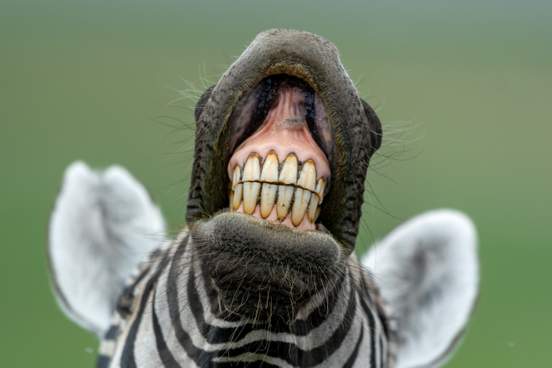
Flehmen
Definition: of mammals : to inhale with the mouth open and upper lip curled to facilitate exposure of the vomeronasal organ to a scent or pheromone
If you’ve spent any time with horses, you may have noticed that they occasionally attempt something similar to the social media fad of “duckface”: they stretch their heads forward and curl their upper lip up so far that it covers their nose. They are not waiting for you to take a pic of them for Instagram (as far as we know), however—they are flehmening.
Flehmening is actually a way of smelling or scenting the air, and is not peculiar to horses: other ungulates exhibit the response, as well as cats, elephants, and bats. Lifting the upper lip gives them access to the vomeronasal organ on the roof of their mouth (other animals use vomeronasal organs as well—snakes particularly), which contains chemoreceptors that help them find mates and investigate other smells in their environment.
Flehmen (also a noun) comes into English directly from German, where it means “to curl the upper lip.” The German verb was coined in the 1930s by zoologists describing the phenomenon, but it didn’t trot into English until the 1970s, where it was first used not of horses, but giraffes.
Miniature llamas, equines, sheep, goats, pigs, and cattle all flehmen.
— Sue Weaver, Storey’s Guide to Raising Miniature Livestock (2012)

Pronk
Definition: a kind of leaping gait (as of a deer, gazelle, or other quadruped)
Pronk was borrowed from Afrikaans (in which language it means "to show off") in the late 19th century, according to the Oxford English Dictionary. The word also functions as a verb, and has been occasionally spotted in extended use.
Many animals bound, among them weasels and cats. The pronk has got to be my favorite. Watch an African wildlife film to see gazelles leap along hitting all four feet together. The quadrupeds’ pronk corresponds to our hop, but it certainly serves them far better.
— Gerry Rising, The Buffalo (New York) News, 30 May 2010Notes from just one day in Sabi Sabi Game Reserve, South Africa: “There are female nyala with fly-whisk tails, tree-high giraffes with supermodel eyelashes, and a statue-still white rhino eyeing us with great suspicion. Impala are pronking in high-hopping shows of athleticism against potential attackers and warthog are mooching about with faces only a mother could love.”
— Susan Kurosawa, The Australian, 2 Sep. 2023
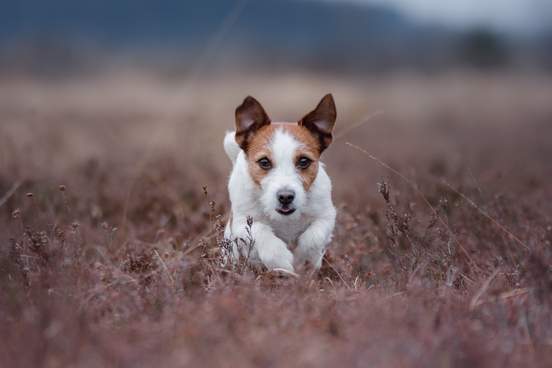
Zoomies
Definition: rapid running, tail chasing, and other energetic and excited behavior in animals and especially dogs that usually indicates happiness, excitement, etc. and lasts for a brief period of time
Sometimes, all pets want to do is zoom-a-zoom-zoom-zoom until they boom-boom into a door jamb or your leg or something, amirite? This behavior has come to be known, in the parlance of our times, as zoomies (and often the zoomies). Zoomies is almost certainly formed from the verb zoom, which first appeared in English in the late 1800s, and is imitative—mimicking the sound of what it describes, i.e. something moving very fast.
Ever notice that your young dog rips and tears through the house just after waking up and just before going to bed at night? I refer to this energy burst as the “zoomies.” Dogs get the zoomies because they need to burn off excessive energy. Some people turn their dogs into the shelter because they think they’re too hyper. This behavior is normal for young pets that need to release energy. Exercise your pet every day to reduce the zoomies.
— Cathy Rosenthal, The San Antonio Express-News, 30 Nov. 2003Dog owners are all too familiar with zoomies, but we don’t often stop and think about zoomies in other species. Hamsters, for example, are known for nocturnal bursts of energy and running on their exercise wheel. Even birds can get the zoomies when feeling energized!
— Gabrielle LaFrank, PetHelpful.com, 29 July 2023
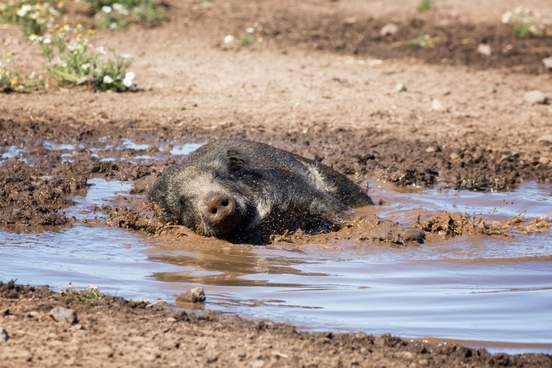
Wallow
Definition: to roll oneself about in a lazy, relaxed, or ungainly manner
As our definition attests, there are many different flavors of wallowing. We’ll allow, for example, one may wallow in self-pity—figuratively “rolling oneself” about in a lazy manner. But for hogs and other porcine fellows, “lazy” may ring hollow. A pig’s gotta do what a pig’s gotta do, unless it’s goetta, if you follow. Pigs wallow because, having fewer sweat glands than humans do, the mud keeps them cool and prevents them from getting sunburn. The word wallow is an ancient one in English, going back to the Old English wealwian and beyond, and is also used as a noun for muddy areas used for wallowing, or depressions formed by or as if by the wallowing of animals.
From the Allegheny River basin—in present-day West Virginia, Pennsylvania, and Ohio—to the Colorado River, huge herds roughed open the earth as they walked across the West, creating wallows, in which grew wildflowers, which drew insects and birds and small mammals, who in turn drew predators.
— Camille T. Dungy, Soil: The Story of a Black Mother’s Garden (Simon & Schuster, 2023)
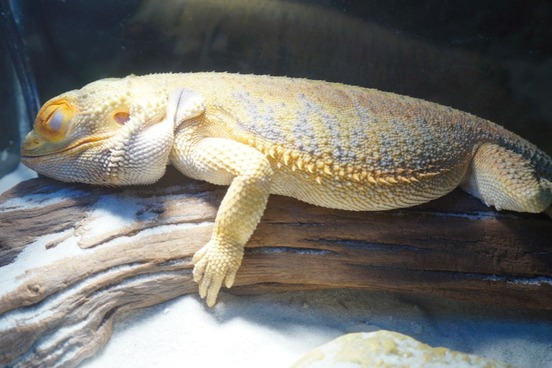
Brumation
Definition: a state or condition of sluggishness, inactivity, or torpor exhibited by reptiles and amphibians during winter or extended periods of low temperature
Not all animal behaviors are as active as binkying and bunting. Case in point, the sleepy state undergone by turtles, toads, et al, known as brumation.
Brumation is one of the few words in English that we can trace back to its point of creation, coined as it was by the American zoologist Wilbur W. Mayhew in a 1965 article titled “Hibernation in the Horned Lizard Phrynosoma m’calli” published in the journal Comparative Biochemistry and Physiology. In it, he writes, “I propose the term brumation (from bruma, L. winter) to indicate winter dormancy in ectothermic vertebrates that demonstrate physiological changes which are independent of body temperature.”
While animals in true hibernation stop drinking water and fall into a deep sleep from which they can’t be awakened, those in brumation still stir occasionally to drink water. Mayhew thought that, given the differences between hibernation and what his reptiles did, it would be best to create a new term.
Brumation is brought on by cold temperatures, but too much heat can cause an animal to go into another torpid state called estivation. As brumation can trace its lineage back to the Latin word for winter, so estivation traces its lineage back to the Latin word for summer.
Although anurans halt general activity during brumation, this does not mean complete brain inactivity.
— Wenbo Liao et al., eLife, 12 Dec. 2023
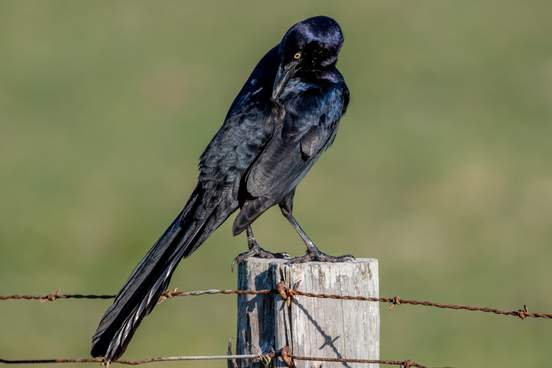
Anting
Definition: bird behavior in which ants are rubbed on the feathers to obtain chemicals (such as formic acid) from the ants
We all have our beauty and hygiene routines, and birds are no different. Many avian species, quail, for example are known to take dust baths to maintain their feathers by absorbing excess oils. Anting is a behavior not so succinctly explained. Some scientists theorize that the formic acid found in ants acts as a fungicide, bactericide, or as an insect repellent. Others believe it prevents their feathers from drying out. Whatever the reason birds—including species of grackle, owl, crow, turkey, and many more—engage in anting, the etymology of the word anting is no mystery.
You might see a Common Grackle hunched over on the ground, wings spread, letting ants crawl over its body and feathers. This is called anting, and grackles are frequent practitioners among the many bird species that do it. The ants secrete formic acid, the chemical in their stings, and this may rid the bird of parasites. In addition to ants, grackles have been seen using walnut juice, lemons and limes, marigold blossoms, chokecherries, and mothballs in a similar fashion.
— AllAboutBirds.org (Cornell Lab of Ornithology), accessed 12 Mar. 2024





